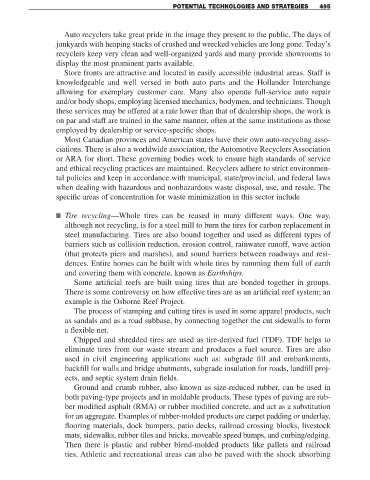Page 517 - Solid Waste Analysis and Minimization a Systems Approach
P. 517
POTENTIAL TECHNOLOGIES AND STRATEGIES 495
Auto recyclers take great pride in the image they present to the public. The days of
junkyards with heaping stacks of crushed and wrecked vehicles are long gone. Today’s
recyclers keep very clean and well-organized yards and many provide showrooms to
display the most prominent parts available.
Store fronts are attractive and located in easily accessible industrial areas. Staff is
knowledgeable and well versed in both auto parts and the Hollander Interchange
allowing for exemplary customer care. Many also operate full-service auto repair
and/or body shops, employing licensed mechanics, bodymen, and technicians. Though
these services may be offered at a rate lower than that of dealership shops, the work is
on par and staff are trained in the same manner, often at the same institutions as those
employed by dealership or service-specific shops.
Most Canadian provinces and American states have their own auto-recycling asso-
ciations. There is also a worldwide association, the Automotive Recyclers Association
or ARA for short. These governing bodies work to ensure high standards of service
and ethical recycling practices are maintained. Recyclers adhere to strict environmen-
tal policies and keep in accordance with municipal, state/provincial, and federal laws
when dealing with hazardous and nonhazardous waste disposal, use, and resale. The
specific areas of concentration for waste minimization in this sector include
■ Tire recycling—Whole tires can be reused in many different ways. One way,
although not recycling, is for a steel mill to burn the tires for carbon replacement in
steel manufacturing. Tires are also bound together and used as different types of
barriers such as collision reduction, erosion control, rainwater runoff, wave action
(that protects piers and marshes), and sound barriers between roadways and resi-
dences. Entire homes can be built with whole tires by ramming them full of earth
and covering them with concrete, known as Earthships.
Some artificial reefs are built using tires that are bonded together in groups.
There is some controversy on how effective tires are as an artificial reef system; an
example is the Osborne Reef Project.
The process of stamping and cutting tires is used in some apparel products, such
as sandals and as a road subbase, by connecting together the cut sidewalls to form
a flexible net.
Chipped and shredded tires are used as tire-derived fuel (TDF). TDF helps to
eliminate tires from our waste stream and produces a fuel source. Tires are also
used in civil engineering applications such as: subgrade fill and embankments,
backfill for walls and bridge abutments, subgrade insulation for roads, landfill proj-
ects, and septic system drain fields.
Ground and crumb rubber, also known as size-reduced rubber, can be used in
both paving-type projects and in moldable products. These types of paving are rub-
ber modified asphalt (RMA) or rubber modified concrete, and act as a substitution
for an aggregate. Examples of rubber-molded products are carpet padding or underlay,
flooring materials, dock bumpers, patio decks, railroad crossing blocks, livestock
mats, sidewalks, rubber tiles and bricks, moveable speed bumps, and curbing/edging.
Then there is plastic and rubber blend-molded products like pallets and railroad
ties. Athletic and recreational areas can also be paved with the shock absorbing

